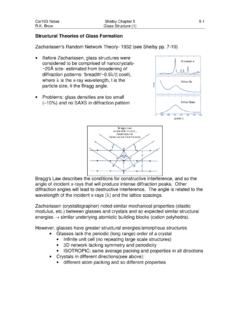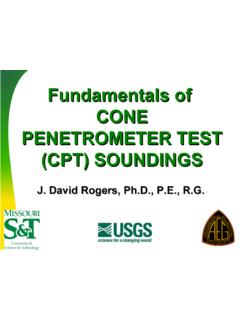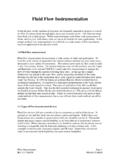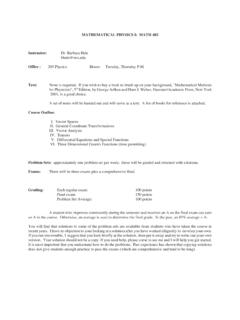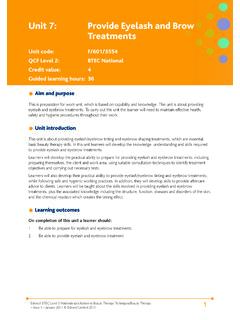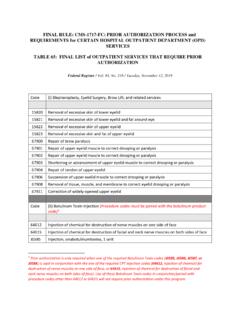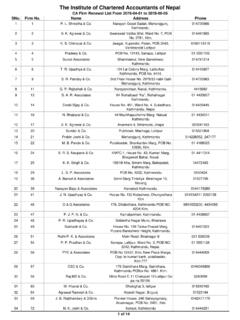Transcription of Chapter 10: Optical Properties - Missouri S&T
1 Cer103 NotesShelby Chapter BrowOptical PropertiesChapter 10: Optical Properties Glasses are among the few solids that transmit visible light Thin film oxides might, but scattering from grains limit their thickness Mica windows at Acoma Pueblo Glasses form the basic elements of virtually all Optical systems World-wide telecommunications by Optical fibers Aesthetic appeal of fine glassware- 'crystal' chandeliers High refractive index/birefringent PbO-based glasses Color in cathedral windows, art glass, Properties1. Bulk Properties : refractive index, Optical dispersion2. Wavelength-dependent Optical Properties : color3. Non-traditional, 'induced' Optical effects: photosensitivity, photochromism,Faraday rotation, Optical Properties History of Optical science parallels the history of Optical glass development Ability to tailor the refractive index and dispersion of glass for telescopesand microscopes led to advances in: Modern astronomyBiologyMedical sciencesEach of these sciences depended on the skills of the glassmakersModern glass science began with the collaboration (late 1800's) of Ernst Abbe: physicist, specialized in Optical design Otto Schott: glass-maker Carl Zeiss: optician/instrument maker1.
2 Refractive Index~(velocity of light in vacuo, or air)/(velocity of light in medium)Snell's Law:note: unitless quantityn (air) = = = = = flint = sinsin= i iIncidentrayReflectedrayRefractedray rCer103 NotesShelby Chapter BrowOptical PropertiesInternal Reflection:Critical angle (Brewster's angle) c belowwhich light is totally reflected:Note: larger n means greater c, and somore light (from a broader distribution ofincident angles) will be internally index materials (diamonds, PbO-glasses) look 'brilliant' when facets are cutso that internal reflection returns light fromlarge faces that originally collected too: internal reflection is important fortransmission of light down an Optical refractive index:Ray tracing techniques: Minimum deviation ( ); Fleming Figure 4 V-block refractometer ( ); Fleming Figure 7 Index Matching Oils ( ) Compare liquids with known indices to samples with unknown indices Samples 'disappear' when indices match Becke line: moves towards higher index medium when stage moveslower.
3 Simple; no special sample cutting/polishing requirednc1sin= cCritical AngleGlass(from Fleming, in Experimental Techniques of Glass Science, 1993)Minimum DeviationRefractometer( )V-blockRefractometer( )sampleCer103 NotesShelby Chapter BrowOptical PropertiesRefractive index depends on dependence is called dispersionShort : higher indexSo, refractive index should be quoted at aspecific wavelength:nD, nm, Na-D line emission (yellow)nF, nm, H-F line emission (blue)nC, nm, H-C line emission (red)(More on dispersion later)Refractive index represents the interaction of light with electrons of theconstituent atoms in a glass. 'n' increases with electron density or polarizability. Low 'n': low atomic # ions: BeF2 glasses, n ; SiO2, B2O3: n polarizable ions (F- for O2-)bridging oxygen for nonbridging oxygens; NBO's increase 'n' increasing R2O increase in 'n' 'n' increases even when smalleratomic# ions (Li, Na) replace Si4+because of the greaterpolarizability of NBO's note that 'n' increases in the seriesNa<K<Li<Rb<Cs the low 'n' for the Li-silicateglasses results from thedecreasing molar volume as theglass structure collapses aroundthe small Li+ ionsredblueDispersionWhite lightShelby (1997) Fig.
4 NotesShelby Chapter BrowOptical PropertiesRefractive index is sensitive to other network structural changes replacing Na2O with Al2O3 in aluminosilicate glasses decreases 'n' becausepolarizable NBO's are replaced by less polarizable Al-O-Si bridging oxygens(Rawson Fig. 90). The Al-CN change in aluminophosphate glasses, from CN=6 to CN=4,replaces a dense structure with a more open network, causing 'n' to decrease(Brow, Fig. 5).High index glasses contain heavy, polarizable ions: Pb, Bi, Tl, Bi2O3 Ga2O3 glasses: visible light 'n' for O2- also increases 'n' asymmetric ions also contribute to large 'n' polarizable sites, in addition to polarizableions Ti-polyhedra: note asymmetry associatedwith the one short Ti=O bond Non-linear Optical applications Basis for PbO-free glassware Nb-polyhedra have similar effectsFictive Temperature Effects:Na-aluminosilicate Glasses(Rawson, Properties and Applicationsof Glasses, 1980)Na-aluminophosphate Glasses(Brow, J.)
5 Amer. Ceram. Soc, 1993)Ti4+OOOOOO(Rawson, Properties and Applications of Glasses,1980)Cer103 NotesShelby Chapter BrowOptical PropertiesNote: 'n' varies by for different quench rates for these Optical required degree of reproducibility (and homogeneity) for many opticalapplications can be two orders of magnitude smaller. Must avoid local variations in 'n' caused by poor annealing Optical glasses generally require much more careful (fine) annealingschedules than other glass products to avoid local heterogeneities in 'n'Temperature Dependence dn/dT depends on composition andproperties of the base glass CTE affects 'n': longer Me-O bonds,more open structure, lower 'n' higher temperature, greater ionpolarizabilities, higher 'n'dn/dT important for a variety of applications self-heating of laser elements- increasing'n' with laser absorption increases self-focusing, runaway damage index match for compositesMolar Refractivity: measure of the contribution of constituent ions in a glass tothe overall refractive index.
6 Dependent on ion Vm is the molar volume and 'n' is the refractive index at the of refractivity is the sum of the individual ionic refractivities (RI):for AxBy, Rm = xRA + yRBNote: Tables of ionic refractivities (right) areoften used to predict the molar refractivity(and so the refractive index) of a glass with aknown composition. Increasing ion size, increasing ionicrefractivity: Li+<Na+<K+; Mg2+<Ca2+<Ba2+ Small, highly charged glass-forming ions(Si4+, P5+) contribute less to the index ofrefraction than the larger modifiers One problem is that RI is not a constant; , ROxygen is greater for NBO's than forBO's (Kreidl figure, below). Rox issensitive to structural Effects(from W. Vogel, in Optical Properties of Glass, 1991) + =2122nnVRmm(from W. Vogel, Chemistry of Glass, 1985)Cer103 NotesShelby Chapter BrowOptical PropertiesDispersion: the variation in index withwavelength: dn/d Associated with the oscillation ofelectrons coupled to light At short wavelengths, 'n' increasesbecause the photons are absorbed bythe promotion of electrons across theoptical band-gap; UV-absorption At longer wavelengths, 'n' increasesbecause photons are absorbed byphonons associated with molecular-scale vibrations; IR-absorption dn/d varies as the approaches eitherthe UV- or IR-edges.
7 (from Kreidl, Glastechn. Ber. 62 213 (1989))Ba-silicate glasses (1) amd crystals (2)Si-NBO sreplaceSi-BO sMg-borate (3) andBa-borate (4) glassesB(4)-O-B(4)replacesB(3)-O-B(3)B(3 )-NBO sform(from Fleming, in ExperimentalTechniques of Glass Science, 1993) Optical Dispersione-UV-edge oroptical band gapSi OCer103 NotesShelby Chapter BrowOptical PropertiesAbbe Number is the practical measure of dispersion of visible light:Note: large Abbe number ( ) means smaller degree of dispersion; smallerdifference index when measured with blue light (nF) vs. red light (nC). Optical glasses are classified with the Abbe that, in general, lower 'n' coincides with greater (less dispersion). Iflight doesn't significantly interact with the constituent ions of a glass, thenboth index and dispersion will be scheme yields different classifications of glasses related to composition: Crown glasses: soda-lime silicates; low index, low dispersion.
8 (named for the British window glass manufacturing process- large blown bubble of glass wastransferred to a pontil, opened, then spun into a circular disk by centrifugal force.) Flint Glasses:lead-containing; high index, high dispersion (low )(named for the high purity silica from 'flint nodules' found in chalk deposits in SE England)Schott Glass Classification: second letter K: crown glasssecond letter F: flint glassfirst letter represents a type; , BK-7 is a borosilicate crown LaF-20 is a lanthanum flint (high n, low )Catalog numbers represent Optical Properties ; first three numbers define 'nD'Last three numbers define ' D'BK-7 (517642): 'nD'= ; D= (682482): 'nD'= ; D= =1 Cer103 NotesShelby Chapter BrowOptical Properties Schott has over 200 glasses in their catalog. Compositions are proprietary,only Optical Properties are reported. Optical designers don't care; rarelyinterested in other Properties (except for dn/dT).
9 Why be concerned with dispersion? Chromic aberrations. A lens will focus red light at a different spot than blue Multiple Optical elements, with different indices and different dispersions, willcorrect this Technologies: diffuse together different glasses to provide the samechromic corrections in a single piece of glass- do not require multiple Absorption(from W. Vogel, Chemistry of Glass, 1985)from Ceramic Bulletin, Sept. 1998e-UV-edge oroptical band gapCer103 NotesShelby Chapter BrowOptical Properties Interband electronic transitions (valence to conduction bands: h/ Egap) for pure SiO2: Egap is 8 eV ( m) UV-photolithography Note: the large increase in 'n' associated with the UV-edge is accompanied bya loss of transmission at these same wavelengths. Ditto for the IR-cutoff. SeeFanderlik, figure 41. Adding alkalis reduces the UV-edge energy (moves the edge to longer ).
10 The closer the UV-edge is to visible frequencies, the greater the visibledispersion ( D). GeO2 has a smaller Egap than other oxide glasses; addition of alkalispushes the edge close to the visible. Resulting increased absorptioncauses yellowish color in alkali germanates. Intensity of the colorincreases with temperature (thermochromism) as Egap decreases. Absolute UV edge is difficult to observe. Small contamination by Fe-impuritieslead to intense absorptions due to charge transfer transitions, overwhelm theEgap transitionsInfrared Absorption transitions associated with phonon vibrations is the frequency of the vibrational absorption energy, F=force constant of thebond (spring) between the two ions and is the 'reduced mass' of the vibratingentity. Note in the above figure from Fanderlik that these transitions are at muchlower energies (longer wavelengths)- for 'clear glasses' these vibrations occurin the IR part of the spectrum.
